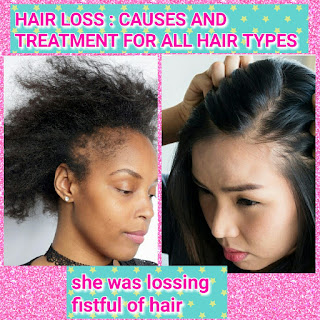2023 HAIR LOSS: causes and treatment for all hair types...
SHE LOST A FISTFUL OF HAIR
hey Queens 💕
hey Queens 💕
Sudden loss of hair can be sometimes alarming but it is mostly cost by stress and grows back .
STORY TIME
A woman in my knitting group recently asked if any of us knew where she could buy a gray wig. Though she seemed to have an ample head of hair, she reported that she’d been losing fistfuls every time she brushed or washed it.
Obviously very upset about what was happening, she said she didn’t want to wait until she was bald to find a substitute for her naturally gray hair.
She also wondered why, suddenly, this was happening and how it could be stopped. The dermatologist she consulted asked some telling questions and suggested the likely cause. Three months earlier, my friend had undergone surgery for colon cancer and, as if that weren’t enough of a stress, she had developed a serious postoperative infection.
The delayed result, a form of diffuse hair loss called telogen effluvium, was causing her hair to fall out in frightening clumps. The good news was that absent another physical or psychological insult, within a year she most likely will have regained her normal head of hair and can donate the wig she bought to a gray-haired woman about to undergo chemotherapy.
In a book about symptoms called “Am I Dying?!” by Drs. Christopher Kelly and Marc Eisenberg, both affiliated with the Columbia University Irving Medical Center, the chapter on hair loss offers a simple description of the three stages of normal hair growth and how they might be disrupted. Under typical circumstances, people have about 100,000 to 150,000 hairs on their heads, with each hair follicle going through its growth cycle independently.
Spared an underlying insult, about 90 percent of your hair is in the anagen, or growth, stage, which can last for years and result in long tresses unless cut. The remaining 10 percent is either in the catagen stage, lasting four to six weeks and during which the hairs start to loosen in their follicles, or the resting telogen stage of two to three months, when the hairs are ready to fall out and end up in the brush, on your clothes or in the shower drain.
It’s normal to shed about 100 to 150 telogen phase hairs a day. But the loss of 100 or more hairs in one washing or brushing is not normal and, as with my friend, likely to cause alarm. This can happen when hair follicles in the anagen phase prematurely progress to the telogen phase and result in abnormal hair loss two to three months later.
In the hair loss chapter of the symptoms book, edited by Dr. Lindsey Bordone, assistant professor of dermatology at Columbia, the authors note that “the intense stress associated with surgery, weight loss, childbirth and any other emotional experience can force most of your hairs into the telogen stage. Since this stage lasts an average of three months, most of your hairs start to fall out after you’ve moved on from the stressor,” prompting you to wonder why it is happening and what can be done to reverse course.
Happily, there is a simple answer to the latter question. Assuming the stressful event has ended, consider getting a wig, head scarf, turban, cap or hat and wait until your hair grows back. Rest assured, if the hair loss was caused by a temporary stress, it will grow back, but patience is highly recommended. Regrowth is usually not apparent for four to six months and may take 12 to 18 months before it is cosmetically acceptable. There’s really nothing that can speed up the process, the doctors write, so don’t waste your money on supplements and other nonmedical hair loss remedies.
Other possible causes of diffuse telogen hair loss include an overactive or underactive thyroid, with normal hair growth restored once the hormonal abnormality is corrected. Various chronic or inflammatory disorders, autoimmune diseases or chronic infections may also cause diffuse telogen hair loss.
Nutritional deficiencies, especially of iron or zinc, protein, fatty acids or vitamin D, are other possible causes, as well as extreme caloric restriction and crash diets. Regardless of what you may suspect, getting a thorough medical checkup is highly recommended to determine a specific and often correctable cause of diffuse hair loss, Dr. Bordone urged.
Loss of hair in the anagen phase is never normal and most commonly results from a toxic exposure like treatment with anticancer drugs. Abnormal hair loss is usually noticed a week or two after the start of chemotherapy and is most apparent by two months. Scalp hair is most likely to be affected, but all facial and body hair may also be lost. However, hair will start to grow back within weeks after chemotherapy ends.
Other causes of anagen hair loss that can be permanent include radiation and heavy metal poisoning. In addition to chemotherapeutic drugs, medications that can sometimes cause hair loss include warfarin, steroids, birth control pills, lithium, amphetamines and vitamin A supplements, though hair will most often grow back when the offending medication is stopped.
The most common form of hair loss is age-related and is not associated with any underlying disease, deficiency or distressing situation. It is androgenetic alopecia, most commonly called male-pattern baldness, or female-pattern baldness when it affects women. This type of hair loss is most common in white men, affecting about half of them by age 50. White women tend to keep their hair longer, though about a third of them experience hair loss marked by a general thinning out of their hair by age 70, the Columbia doctors report.
Several medications are available that can help to counter androgenetic alopecia, at least to some extent. One is minoxidil, a scalp cream sold as Rogaine, among other brands; another is a pill called finasteride, sold as Propecia. The latter can help to shrink an enlarged prostate and improve urination, but in 1 percent of men it can cause sexual dysfunction.
Women can also use minoxidil to counter hair-thinning caused by androgenetic alopecia. However, some women contribute to their hair loss by adopting tight hairstyles like a ponytail or cornrows that tug on the hair, practices that prompted the Columbia doctors to recommend letting your hair down.
The most mystifying form of hair loss, called alopecia areata, results from an attack on hair follicles by the body’s own immune system. It usually results in smooth, coin-size bald patches on the head, although the autoimmune attack on hair follicles can also affect a man’s beard, all the hair on a person’s head, or all the hair on the entire body. Hair regrows within a year in about half of patients, although hair loss can sometimes recur, the doctors said.



Comments